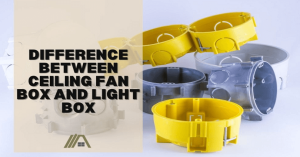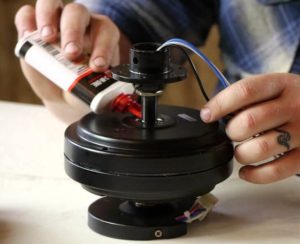Ceiling fan wattage limiters can serve as valuable tools in minimizing the energy consumption of ceiling fans. Nevertheless, they can also pose certain issues, such as affecting the functionality of light fixtures or excessively restricting the wattage output.
To address these concerns, many homeowners, myself included, get the option to remove the wattage limiter. However, it is very important to give preference to caution when dealing with electrical devices within electrical systems, as a thorough knowledge of their purpose is necessary for proper handling.
Ceiling fan wattage limiters serve the purpose of regulating the power consumption of ceiling fan lighting kits, ensuring they do not exceed safe limits. It’s important to note that these limiters are not directly related to the safety of the fan itself. Therefore, removing the wattage limiter is generally considered safe and does not pose any significant risks.
What Is a Ceiling Fan Wattage Limiter?
A ceiling fan wattage limiter is a box-shaped device typically included with some ceiling fan models. Its primary function is to regulate and limit the amount of electrical power supplied to the ceiling fan’s lighting kit. By reducing the flow of electricity, the wattage limiter effectively lowers the wattage consumption of the fan, promoting energy conservation.
Why Do Fans Contain Wattage Limiters?
Ceiling fans are equipped with wattage limiters primarily to comply with energy conservation regulations set by the Department of Energy through the Energy Policy Act of 2005. This act ensures that ceiling fan lighting kits should not exceed a power consumption of 190 watts.
While the specific use of wattage limiters is not explicitly mentioned in the act(I could not find it), it has become a preferred method to achieve the required energy limitation.
The implementation of wattage limiters in ceiling fan light kits caused dissatisfaction among ceiling fan manufacturers due to frequent failures and the subsequent increase in warranty-related costs.
Responding to the concerns raised by these companies, the government reevaluated the regulations related to wattage limiters for ceiling fan light kits. As a result, they acknowledged that alternative approaches exist to ensure energy efficiency, as documented on pages 19-20 of the DOE Docket No. EERE-2014-BT-TP-0007. This reevaluation signaled a willingness to explore other methods that can achieve the desired energy conservation goals without relying solely on wattage limiters.
In modern times, wattage limiters are still occasionally used for their practical function of reducing energy consumption and ensuring compliance with energy use standards.
Additionally, older or used ceiling fans may still have wattage limiters installed if they were manufactured during the period when the original energy act was in effect.
Wattage Limiters Don’t Play a Safety Role
You might be thinking that removing the wattage limiter will pose a threat to your safety but removing the wattage limiter from your ceiling fan does not pose a safety threat as its role is solely related to energy conservation and not safety measures.
To address your concerns, it’s important to understand the other components of the ceiling fan that are specifically designed to ensure safety against the risks of electrocution and fire. These components include:
- Grounding wire. It directs excess current away from the device and anyone who may come in contact with it, thus minimizing the risk of electric shock.
- Thermal fuse. This device automatically cuts off power to the fan if it becomes overheated, mitigating the potential fire hazard.
- Breaker/fuse. These protective mechanisms prevent excessive electrical current from entering the circuit, thereby safeguarding the fan from damage and reducing the risks of fire or electric shock.
When removing the wattage limiter, the only potential danger lies in the process itself since it is connected to the circuit.
However, this risk can be taken care of by following proper safety procedures, such as turning off the fan at the breaker before attempting any removal.
Problems with Wattage Limiters
Wattage limiters, despite their helpful purpose, can sometimes present problems that can be frustrating to deal with. One common issue is their tendency to fail, resulting in a mysterious and prolonged investigation to identify the cause.
The problems arise when the limiters excessively restrict the wattage to the ceiling fan lighting kit, and there are several factors that can contribute to this:
- A faulty limiter or may be incorrectly set to a lower wattage than the designated limit (190 W). However, there are troubleshooting steps that can be taken to address this issue
- Limiters need to be appropriately sized based on the maximum wattage they can handle. If the limiter is the incorrect size, it can impede the wattage regulation.
- If the wattage limiter is damaged or broken in any way, it can malfunction and excessively restrict the wattage flow.
When wattage limiters are not functioning properly, they can affect both the ceiling fan lights and the fan motor itself.
For instance, the lights may become dimly, flicker, or unpredictably turn on and off as the limiter attempts to save power.
Additionally, the limiter can limit the fan’s speed options or restrict the fan from operating unless the lights in the attached fixture are turned off. These issues can disrupt the desired functionality of the ceiling fan.
Should You Remove the Wattage Limiter?
After understanding the safety aspects of removing a wattage limiter from a ceiling fan, another important question to consider is whether it is necessary to remove it in the first place. There are a few factors to think about before making a decision.
Firstly, assess whether you are experiencing any issues with the functioning of your ceiling fan or light fixture. If everything is working properly, there may be no compelling reason to remove the limiter.
However, if you are facing problems with your ceiling fan and its lights, it’s important to keep in mind that removing the limiter may not necessarily solve those issues. It’s only one possibility among various potential causes.
Moreover, removing the wattage limiter may make your ceiling fan non-compliant with energy usage standards. This can impact your fan’s warranty, industry certifications, and even affect the outcome of a home inspection
Consider alternative solutions before reaching the decision of limiter removal. For instance, if the issues primarily affect CFL bulbs, you could explore replacing them with energy-efficient alternatives that provide similar brightness levels.
In any case, you need to conduct thorough research and explore all available options is crucial before making a final decision to permanently remove the wattage limiter
Where to Locate the Wattage Limiter
To find the wattage limiter, you should have a look inside the wiring box within the light fixture of your ceiling fan.
Inside this box, you will come across a small, black or gray box connected to several red and/or blue wires. This box is the wattage limiter.
In case you face difficulties in finding the wattage limiter, simply follow the wires connected to the bulbs in the fixture. Trace these wires until you locate the limiter.
Remove to Test Issue
If you suspect that the wattage limiter might be causing issues with your ceiling fan and lights, you can remove it as a troubleshooting step to identify the underlying problem.
By removing the limiter, you can determine whether it is the cause of the issue. If you remove the wattage limiter and the problem persists, it indicates that the limiter is not the source of the issue. In such a case, you should reinstall the limiter and explore other possible causes and solutions for the problem
On the other hand, if you remove the wattage limiter and your fan and lights start working properly, it suggests that the limiter is faulty.
If that is the case, you can resolve the issues by purchasing a new wattage limiter and replacing the old, faulty one. On the other hand, if you prefer, you can choose not to use a limiter at all
It’s worth considering whether the issues with the wattage limiter could be caused by other parts of the ceiling fan. If the fan was installed correctly, used appropriately, and equipped with the correct size and type of components, the limiter should not impact its functioning.
However, if you have installed larger fan blades than the original ones, this could potentially affect the fan’s operation in relation to the limiter, as larger blades require more power to rotate.
How to Remove a Wattage Limiter?
Here’s a step-by-step guide on how to remove a wattage limiter from your ceiling fan:
- Before starting any electrical work, ensure that the electricity is switched off at the circuit breaker to change the limiter.
- Remove the light fixture and/or its covering from the fan to access the wiring inside the fan. This is usually done by unscrewing the fixture or removing any decorative covers.
- Find the wattage limiter within the wiring box. It is a small box-shaped device with three wires: black, red, and white.
- Use the wire cutters to cut all three wires as close to the box as possible, allowing for a longer length to work with.
- Terminate the white wire by capping it off securely.
- Splice the black and red wires together. If needed, strip off some insulation from the wires to ensure a good splice.
- Cover the new spliced wires with a wire nut or cap to protect the connection.
- Reattach the lighting fixture onto the ceiling fan by screwing it back into place to complete the procedure.
Once the limiter has been removed and the connections have been secured, you can turn the power back on at the circuit breaker. Test the lights to ensure they are functioning properly.



